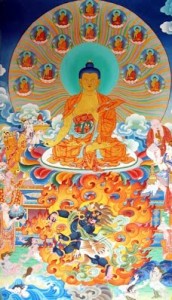

9:00am–11:00am Chötrul Düchen: One of the four Great Buddhist Festivals
February 27, 2021 @ 9:00 am - 11:00 am
Chötrul Düchen Day (Great Day of Miraculous Manifestations):
Please join us in the feast practice of the Buddha Sadhana for a celebration of Chotrul Düchen (Festival of the Buddha’s Great Miracles).
Suggested contribution for lunch: $10. The event itself is for free.
Brief description of Chotrul Düchen:
Chotrul Düchen — “Festival of (Buddha Śākyamuni’s) Miracles” — is one of the four great deeds and four great Buddhist festivals. It occurs on the fifteenth day of the first Tibetan month. The first fifteen days of the year celebrate the fifteen days during which, in Śrāvasti, the historical Buddha Śākyamuni displayed a different miracle every day to increase the merit and the devotion of present and future disciples and sentient beings, helping them to attain great advancement. This festival is therefore also called Chonga Chöpa (Tib. cho lnga mchod pa = 15th offering). Therefore, during this time, it is believed that the effects of both positive and negative actions are multiplied ten million times.
Below is a brief traditional “poetical” account of the month of miracles in Śrāvastī:
The leaders of India’s six main philosophical schools had challenged the Buddha to a contest of miraculous powers many times as he wandered through the surrounding kingdoms. When King Bimbisara requested the Buddha’s participation at Rājagṛha, the Buddha agreed but stipulated that he would set the time of the contest. On the other hand, shortly before the proposed contest, the Buddha and all his followers departed for Vaiśālī.
The Buddha moved on, from one city to the next; each time giving the same answer, and gathering a new following, until they came to Śrāvastī. The six non-Buddhist teachers soon arrived, and remonstrate with King Prasenajit not to allow any further postponement, and the Buddha assented that the time had now come. Buddha was fifty-seven years old when the conditions were most auspicious to accept this challenge.
King Prasenajit built a hall in Śrāvastī especially for the event; in it seven thrones were erected. On the new moon of the first month of spring (what is now known as Losar, the beginning of the Tibetan new year), the six other teachers took their seats and Śākyamuni came to his flying through the air. He was honored with extensive offerings. He then sent forth fire and water from his body and the hall was destroyed and reformed as a transparent palace.
Before the kings of all the capitals he had passed through, the six non-Buddhist teachers and their followers, and a huge assembly of gods and humans, he performed inconceivable miracles for the next fifteen days.
On the first day, he created a bounteous tree by planting his tooth-pick in the ground, causing a great tree to spring up, fragrant and fully laden with flowers and ripe fruit. On the second day, he manifested two jeweled mountains. On the third day, he produced a jewel lake. On the fourth, voices came from the lake explaining all aspects of the Dharma. On the fifth day, golden light spread from his countenance and filled the world, purifying the emotional poisons of sentient beings. On the sixth day, he allowed people to read each others’ thoughts. On the seventh, he transformed his benefactors into world-rulers. On the eighth day, the Buddha pressed down on the throne with the fingers of his right hand, and with a thunderous roar, the fierce Vajrapāṇi appeared from beneath, brandishing a flaming vajra at the heretic teachers. Four beings in Vajrapāṇi’s retinue scattered the non-Buddhist teachers and smashed their thrones. The non-Buddhist teachers were so scared that they leapt into the river. Then, the Buddha radiated eighty four thousand rays of light, one from each pore of his skin, which filled the sky. On the tip of each ray was a lotus, and on each lotus a buddha, with attendants, teaching Dharma, and all were amazed, and some were liberated by the sight of it.
In these eight days Buddha Śākyamuni utterly defeated his opponents. The ninety thousand followers of the six non-Buddhist teachers adopted the Buddhist doctrines, joined the monkhood, and later became arhats.
For a further seven days Buddha Śākyamuni continued to show miracles and give teachings to the great assembly.
(Extracted from The Eight Places of Buddhist Pilgrimage by Jeremy Russell; Teachings from Tushita: Journal of Tushita Mahayana Meditation Centre; and The Twelve Deeds of the Buddha by Matthew Akester, Shechen Publications, 2003.)
